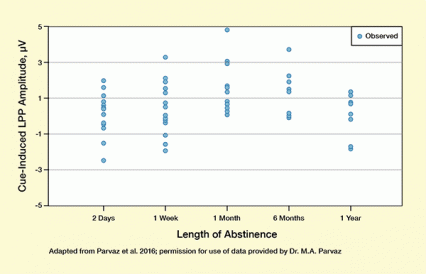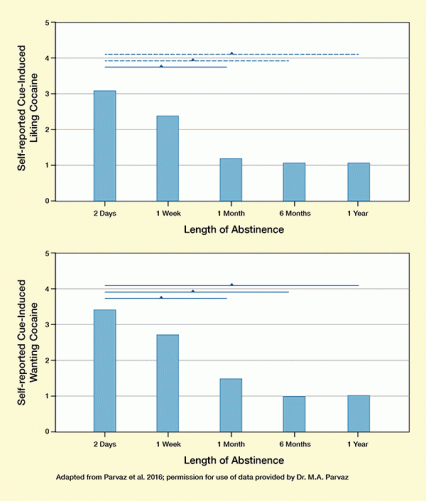This research:
- Suggests that electroencephalography (EEG) may provide an objective measure of cocaine-addicted participants’ vulnerability to cue-induced relapse.
- Indicates that the period from 1 to 6 months of abstinence is a time of increased vulnerability to cue-induced relapse to cocaine.
Studies have shown that people who cease taking some drugs experience “incubation” of cue-induced craving, whereby cues that they associate with the drug elicit craving that is mild at first, becomes stronger with longer abstinence, then fades. Incubation has been demonstrated following cessation of alcohol, nicotine, and methamphetamine, but not to the same degree with all of them, and not with all drugs—for example, not with heroin. However, some or all of this variability may stem from studies’ use of subjective measures of cue reactivity, such as self-reported craving, rather than objective measurements.
Dr. Muhammad A. Parvaz and colleagues from the Icahn School of Medicine at Mount Sinai, New York, recently demonstrated that a component of cocaine-dependent participants’ electroencephalography (EEG) signal follows an incubation-like trajectory in response to drug cues. Besides affirming other evidence indicating that cocaine-dependent participants’ craving incubates, the finding suggests that EEG can provide an objective measure of susceptibility to relapse cues. If borne out in future research, it may pave the way for relapse prevention treatments that fit participants’ vulnerability to cue-induced relapse at each point in the incubation trajectory.
The Mount Sinai team obtained EEG recordings of 76 people with cocaine dependence while exposing them to photographs of cocaine preparation and use. The study participants had been abstinent for 2 days (25 percent), 1 week (26 percent), 1 month (20 percent), 6 months (16 percent), or 1 year (13 percent).
The researchers compared the five participant groups’ EEGs, focusing on a component that they interpreted as an indicator of the intensity of cue-induced cocaine craving. Previous studies had linked the amplitude of this component, called the late positive potential (LPP), to participants’ self-reports of cocaine craving. More generally, studies have indicated that LPP amplitude reflects the strength of attentional and emotional responses to motivational cues, including drug cues.
 Figure 1. Late Positive Potential (LPP) Measurements in Response to Photographic Cocaine Cues in Cocaine-Addicted Adults Abstinent for Various Lengths of Time The amplitude of LPP cue reactivity was higher in study participants who had been abstinent for 1 month or 6 months than in those who had been abstinent for 2 days, 1 week, or 1 year. These findings suggest the presence of an incubation effect for cue-induced relapse vulnerability.
Figure 1. Late Positive Potential (LPP) Measurements in Response to Photographic Cocaine Cues in Cocaine-Addicted Adults Abstinent for Various Lengths of Time The amplitude of LPP cue reactivity was higher in study participants who had been abstinent for 1 month or 6 months than in those who had been abstinent for 2 days, 1 week, or 1 year. These findings suggest the presence of an incubation effect for cue-induced relapse vulnerability.
- Text Description for Figure 1
-
The figure shows measurements of a component of the electroencephalogram called late positive potential (LLP) in people with cocaine addiction who had been abstinent for various lengths of time and were then exposed to photographic cocaine cues. The horizontal (x) axis shows the length of abstinence, with the categories of 2 days, 1 week, 1 month, 6 months, and 1 year. The vertical (y) axis shows the cue-induced LLP amplitude in microvolt (μV) from -5 to +5. Each light blue circle represents the measurement from one participant. For participants who had been abstinent for 2 days, the amplitude ranged from approximately -2.5 μV to +2.0 μV; for those who had been abstinent for 1 week it ranged from approximately -2.0 μV to +3.2 μV; for those who had been abstinent for 1 month it ranged from approximately 0 μV to +5.0 μV; for those who had been abstinent for 6 months from approximately -0.2 μV to +3.7 μV; and for those who had been abstinent for 1 year from approximately -2.0 μV to +1.5 μV. This suggest the presence of an incubation effect for cue-induced relapse vulnerability, with the greatest vulnerability at 1 month to 6 months of abstinence.
The researchers’ comparison revealed a pattern consistent with incubation of cue-induced craving: The participants with 1 month or 6 months of abstinence exhibited higher LPP amplitude when viewing the photographs than the participants with shorter or longer abstinence (see Figure 1).
The parabolic trajectory traced by the study participants’ LPP amplitude parallels observations of animals’ willingness to work for cocaine after varying lengths of abstinence. In contrast, the participants’ ratings of how much they “liked” and “wanted to use” cocaine after viewing the photographs declined linearly with increasing length of abstinence (see Figure 2). Accordingly, the researchers propose that LPP amplitude is a better gauge of cocaine-dependent participants’ vulnerability to relapse than the participants’ ratings of their desire for the drug.
The Mount Sinai researchers’ findings indicate that cocaine-addicted adults may be most vulnerable to relapse after 1 to 6 months of abstinence (a timeframe in which most are discharged from treatment), but may not be aware of this vulnerability. If further studies replicate the findings, EEG assessment of cue-induced responsiveness may be useful in the clinical setting for assessing relapse risk and tailoring interventions to maintain abstinence among cocaine-addicted adults.
This research was supported by NIH grants DA033088, DA40046, DA023579, DA034954-01, and DA041528-01.
 Figure 2. Subjective Craving in Response to Photographic Cocaine Cues in Cocaine-Addicted Adults Abstinent for Various Lengths of Time In contrast to the findings for EEG cue reactivity (Figure 1), subjective measures of craving (e.g., “liking cocaine,” “wanting to use cocaine”) decreased in a linear manner with increasing duration of abstinence. The horizontal lines above the bars indicate statistically significant differences between the groups (solid lines: P < 0.05; dotted lines: P < 0.10).
Figure 2. Subjective Craving in Response to Photographic Cocaine Cues in Cocaine-Addicted Adults Abstinent for Various Lengths of Time In contrast to the findings for EEG cue reactivity (Figure 1), subjective measures of craving (e.g., “liking cocaine,” “wanting to use cocaine”) decreased in a linear manner with increasing duration of abstinence. The horizontal lines above the bars indicate statistically significant differences between the groups (solid lines: P < 0.05; dotted lines: P < 0.10).
- Text Description for Figure 2
-
The figure shows two bar charts illustrating self-reported craving responses in cocaine-addicted people who had been abstinent for various lengths of time and were then exposed to photographic cocaine cues. The horizontal (x) axis shows the length of abstinence, with the categories of 2 days, 1 week, 1 month, 6 months, and 1 year. The vertical (y) axes show the cue-induced craving as represented by self-reported “liking cocaine” (top panel) and self-reported “wanting cocaine” (bottom panel), rated on a scale from 0 to 5. The rating for self-reported cue-induced “liking cocaine” declined from about 3.1 at 2 days of abstinence to about 2.4 at 1 week of abstinence, 1.2 at 1 month, and about 1.0 at 6 months and 1 year of abstinence. For self-reported cue-induced “wanting cocaine,” the rating declined from approximately 3.4 at 2 days of abstinence to about 2.7 at 1 week, 1.5 at 1 month, and 1.0 at 6 months and 1 year of abstinence. Horizontal lines above the bars indicate statistical significance between the rating at 2 days of abstinence and at 1 month, 6 months, and 1 year of abstinence, respectively. Dotted lines indicate a P <0.10 and solid lines indicate a P <0.05.
Source:
Parvaz, M.A., Moeller, S.J., and Goldstein, R.Z. Incubation of cue-induced craving in adults addicted to cocaine measured by electroencephalography. JAMA Psychiatry 73(11):1127-1134, 2016.
